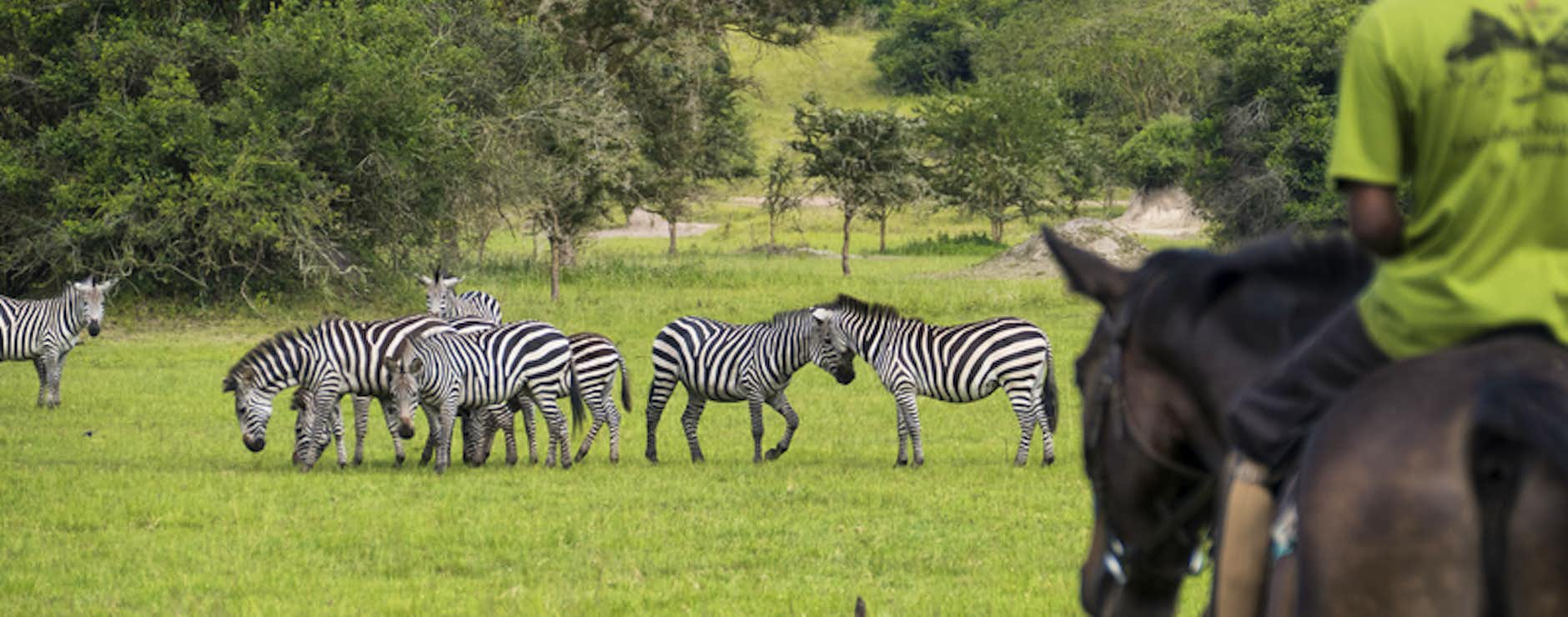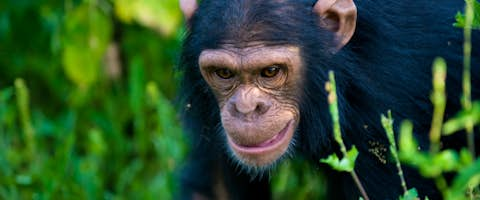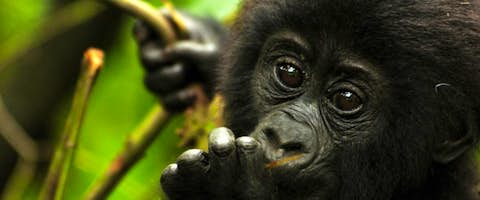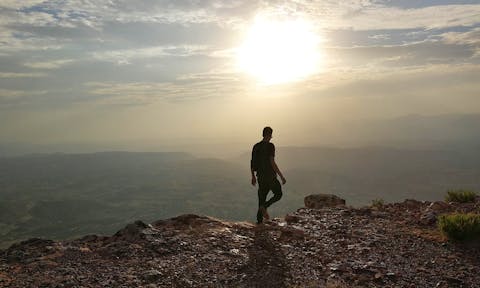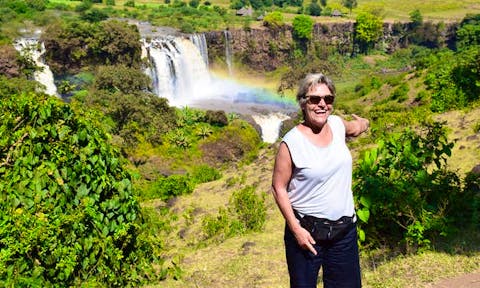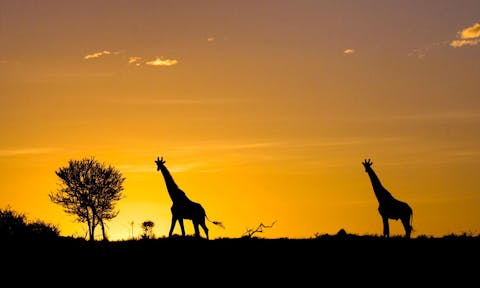Lake Mburo National Pak, at a glance

Located basically equidistant between Bwindi Impenetrable Forest and Entebbe, the woodlands, waters and grasslands make for the perfect break in a road journey either to or from the gorillas.
If returning from the gorillas, try to stay a night longer than you initially think necessary; Mburo is the perfect place in which to relax as well as explore.
If you live in Kampala or Entebbe, then Mburo is also a great location for a long weekend getaway.
Although just 260km², Mburo provides a wonderful variety of habitats, with 20% of its surface area made up of lakes and marshland.
Discover the park
Although there are no elephants and only one lion (a lonely visitor from Tanzania), there are impala, Burchell’s zebra, eland, buffalo, leopard and wonderfully diverse birdlife.
The landscapes and wildlife can be explored in game drives, by boat, on horseback and by mountain bike in the continuous ranch lands outside the park. These options make Mburo a very modern safari destination, attractive to visitors with a wide variety of interests.
Like Queen Elizabeth National Park, Mburo was born from the rinderpest and tsetse fly epidemics of the late 19th and early 20th centuries. But unlike Queen Elizabeth, the communities that historically utilised Mburo were displaced, destroying local support for the park.
Happily, the creation of the Mburo Community Conservation Unit in 1991 has helped mitigate past grievances and now ensures that 20% of the income generated by park fees is used to fund local community projects.

Places to Stay at Lake Mburo
The popularity of Mburo has grown in recent years, resulting in the construction of a number of lodges. Three of the most popular are Rwakobo Rock, Lake Mburo Camp and Mihingo Lodge.
Rwakobo Rock
Rwakobo Rock occupies a rocky outcrop on the border of the park, 1km from the Nshara Gate, with beautiful views into Mburo.
There are eight homely and spacious cottages built from local materials. The swimming pool has spectacular views, shared by the large dining room and bar.
In addition to the normal Mburo activities, Rwakobo also organises mountain bike tours of the savanna outside the park border, which is a great way to stretch your legs after a drive whilst also seeing some of the local wildlife.
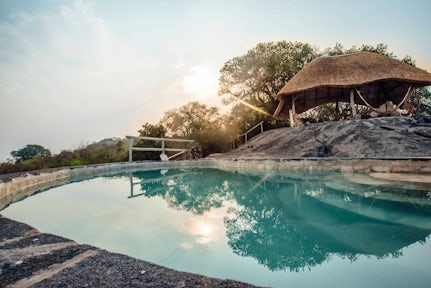
Lake Mburo Camp
Lake Mburo Camp is a traditional, tented, bush camp located in the centre of the Park.
The tents are elevated on wooden platforms, from which you can watch the life unfolding in the savanna.
A homely dining room and bar provides the perfect place to unwind after the day. Lake Mburo Camp is a sister property of the ever-popular Engagi Lodge in Buhoma.
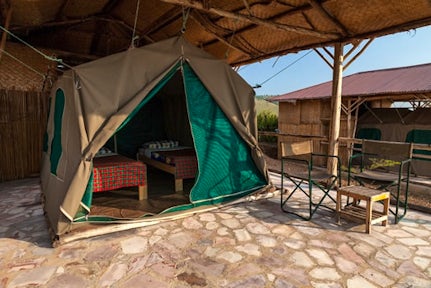
Mihingo Lodge
Mihingo Lodge is a beautiful luxury lodge set in a private 97ha reserve bordering the park. Like Rwakobo, it has been built sympathetically into an extensive rocky outcrop - home to leopards as well as visitors.
The 12 tented rooms have been designed and built with great attention to detail, making sure they complement the local environment. An hour or two in the infinity pool is one of the most relaxing experiences in Uganda.
Mihingo also operate the high quality horse safaris available in the park.

Things to do at Lake Mburo National Park
Game Drives

The park has a network of game drive tracks. The wildlife densities will vary depending on the time of year, plus the lack of elephants is allowing thick scrub to grow where there were grassy plains.
However, each drive normally has a great chance of finding substantial concentrations of impala, zebra, waterbuck, topi and buffalo.
The re-introduced giraffe are more commonly seen from the Kazuma and Ruroko tracks. You may also see the shy eland, who now number over 100.
It is now also possible to experience the park in darkness on two to three-hour night game drives. These normally start about 6:30pm and are a wonderful way to see nocturnal animals like bushbabies and potto, plus leopard and hyena at their most active.
Walking Safari

In Mburo, the whole park is available to explore on foot, as long as you take a guide with you. Favourite trails are to the salt lick at Rwonyo, the lake shorelines, Rubanga Forest and viewpoint hill tops.
Walks are the most exciting way to discover the park because visibility is often restricted by the undergrowth and it is difficult to see buffalo holding their ground or hyena loping back to their dens after a night on the prowl.
Walks are also the best way for birders to track down the more elusive species.
Boat Safari
Taking to the water is always a welcome, peaceful, part of any safari. You escape the dust and the tsetse flies and see life in the bush from another angle.
A 90-minute morning boat safari takes you along the shore of Lake Mburo, including sightings of crocodile, buffalo, hippo, kingfishers, fish eagles and hammerkops.
The boat safaris start at 8 am and depart every two hours until 4 pm.
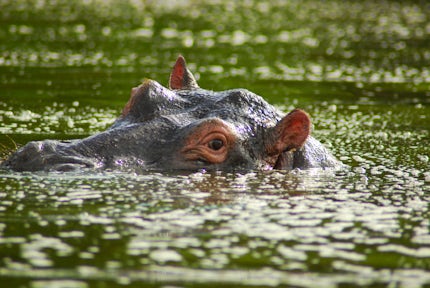
Birding
The acacia woodland and wetlands of Mburo make it a popular destination for birders. Searching by vehicle and on foot, sightings are also facilitated by viewing platforms constructed within the forest and by salt-licks.
The swampy valleys of Waruki and Miriti, plus the roadsides approaching the jetty provide the best birding spots.
Species seen here include the Rufous-bellied heron, bateleur, black-bellied bustard, and the red-faced barbet, the latter found only in Lake Mburo National Park.

Horse Riding
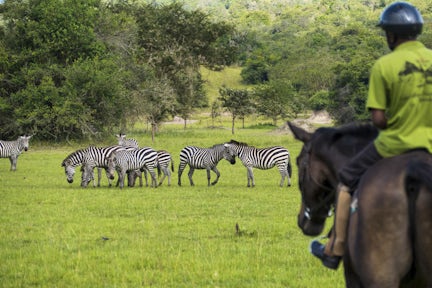
Amazing close: a dazzle of zebra in Lake Mburo
Mburo is the only place in Uganda where you can ride horses in a national park. Operating out of the Mihingo Lodge stable, all abilities and ages are catered for.
Buffalo and zebra react very differently to a human on horseback and so this is a special way to move among the wildlife.
The rides last for four hours and often include hill-top sundowners or bush breakfasts.
Mountain Biking
Rwakobo Rock maintains a good selection of well-maintained mountain bikes and offers guided rides through the savanna that borders the park.
This is the perfect way to burn off some energy while also enjoying wildlife and meeting members of the local community.

In 2012, the Uganda Wildlife Authority opened mountain biking trails.
Geography & Geology of Lake Mburo

Uganda’s smallest savanna national park is located in the southern Ankole region halfway between Bwindi and Entebbe/Kampala. It is 260km² of lakes, swamps, grassland and acacia woodland. With low hills rising from the lake shore, it is reminiscent of parts of Zululand and Akagera National Park in Rwanda.
The underlying Pre-Cambrian bedrock dates back over 500 million years and supports sandy, well-drained, soils. Located in the ‘rain shadow’ between Lake Victoria and the Rwenzori Mountains, Mburo has a relatively low annual rainfall of 800mm, similar to Kidepo.
Despite this 20% of the park is made up of wetland habitats, most notably five lakes, the largest of which being the 13km² Lake Mburo. Aside from grassland, the other main habitat is acacia woodland.
The altitude of the park ranges from 1,220m to 1,828m above sea level.
Flora & Fauna of Lake Mburo
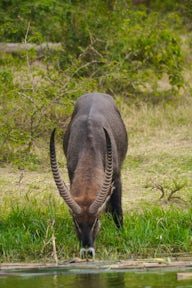
Mburo is home to several species that, although common elsewhere in Africa, are found only in the park or otherwise rarely within Uganda. It is the only place you will find impala and one of only two places in the country you will find Burchell’s zebra and eland.
There are 68 mammal species. In additional to buffalo, hippo, giraffe, warthog and the previously mentioned zebra and eland, other commonly seen antelope species are topi, common duiker, oribi, Defasa waterbuck, Bohor reedbuck and bushbuck.
Eland are elusive, but present in large numbers and are a majestic sight when spotted. Sitatunga occupy wetland interiors, while klipspringer are seen around rocky outcrops. You will see vervet monkey and olive baboon. While guests at Mihingo Lodge may be lucky to see the extremely rare greater galago.
Predators are present in good number, but there is only one lion - a solitary male who is reputed to have entered the park from distant Tanzania. However, spotted hyena are often seen in large groups and leopard are increasingly visible.
Around 315 bird species have been recorded to date. The swamps and the acacia forests are the habitats with the greatest diversity. The Red-faced Barbet is only seen in Lake Mburo; the endemic African Finfoot is a popular sighting, and the swamps are home to six papyrus endemics.
When to Visit and How to Get There

The best time for general wildlife viewing is in the dryer seasons from June to August and December to January.
However, Lake Mburo National Park is still wonderful to visit in the wetter seasons from March to May and September to November.
Mburo is only accessible by road. Entebbe/Kampala's journey takes about five to six hours; the journey to Buhoma, Bwindi is the same.
Popular Trips to Uganda
The tours below showcase just some of what is possible. Use these itineraries as starting points, or to draw inspiration. Then get in touch, and let our expert team help craft the perfect itinerary for you.
Thinking about visiting Uganda?
Listen
We'll spend some time listening to your aspirations, then discuss the kind of experience that might suit you.
Match
Next we'll discuss the options, shortlist the best trips for you and present you our impartial recommendations.
Reserve
We'll place a 24 hour hold on your preferred option - without obligation - whilst we talk through the details.
Get in touch and we can help you understand your options, design an itinerary that's right for you, and then get you set up and ready to go.
+1 315 645 2889

